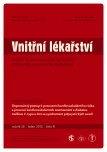Endocrine changes in liver disease
Authors:
J. Kollerová; T. Koller; J. Payer
Authors‘ workplace:
V. interná klinika Lekárskej fakulty UK a UNB Bratislava, Slovenská republika, prednosta prof. MUDr. Juraj Payer, CSc.
Published in:
Vnitř Lék 2012; 58(1): 24-30
Category:
Reviews
Overview
Liver diseases have an influence on function and morphology of all endocrine glands. Knowledge of these specific changes is important in correct interpretation of pathological clinical and laboratory hormonal symptoms and signs induced by liver disease. We analyze the influence on the thyroid, bone metabolism, adrenocorticotropic axis, gonadal hormones, prolactin and growth hormone.
Key words:
liver – liver disease – thyroid disease – bone changes – cortisol – gonadal hormones – prolactin – growth hormone
Sources
1. Liewendahl K, Helenius T, Tanner P et al. Serum free thyroid hormone concentrations and indices in alcoholic liver cirrhosis, primary biliary cirrhosis and chronic active hepatitis. Acta Endocrinol Suppl (Copenh) 1983; 251: 21–26.
2. Antonelli A, Ferri C, Ferrari SM et al. Endocrine manifestations of hepatitis C virus infection. Nat Clin Pract Endocrinol Metab 2009; 5: 26–34.
3. Pateron D, Hartmann DJ, Duclos-Vallée JC et al. Latent autoimmune thyroid disease in patients with chronic HCV hepatitis. J Hepatol 1993; 17: 417–419.
4. Antonelli A, Ferri C, Fallahi P et al. Thyroid disorders in chronic hepatitis C virus infection. Thyroid 2006; 16: 563–572.
5. Antonelli A, Ferri C, Pampana A et al. Thyroid disorders in chronic hepatitis C. Am J Med 2004; 117: 10–13.
6. Matskevich AA, Strayer DS. Exploiting hepatitis C virus activation of NFkappaB to deliver HCV-responsive expression of interferons alpha and gamma. Gene Ther 2003; 10: 1861–1873.
7. Murata M, Nabeshima S, Maeda N et al. Increased frequency of IFN-gamma-producing peripheral CD8+ T cells with memory-phenotype in patients with chronic hepatitis C. J Med Virol 2002; 67: 162–170.
8. Antonelli A, Ferri C, Fallahi P et al. Thyroid cancer in HCV-related chronic hepatitis patients: a case-control study. Thyroid 2007; 17: 447–451.
9. Giordano TP, Henderson L, Landgren O et al. Risk of non-Hodgkin lymphoma and lymphoproliferative precursor diseases in US veterans with hepatitis C virus. JAMA 2007; 297: 2010–2017.
10. Güven K, Kelestimur F, Yücesoy M. Thyroid function tests in non-alcoholic cirrhotic patients with hepatic encephalopathy. Eur J Med 1993; 2: 83–85.
11. Gelu-Simeon M, Burlaud A, Young J et al. Evolution and predictive factors of thyroid disorder due to interferon alpha in the treatment of hepatitis C. World J Gastroenterol 2009; 15: 328–333.
12. Kirch W, Höfig M, Ledendecker T et al. Parathyroid hormone and cirrhosis of the liver. J Clin Endocrinol Metab 1990; 71: 1561–1566.
13. Groote Veldman R, Meinders AE. On the mechanism of alcohol-induced pseudo-Cushing’s syndrome. Endocr Rev 1996; 17: 262–268.
14. Marik PE, Gayowski T, Starzl TE. Hepatic Cortisol Research and Adrenal Pathophysiology Study Group. The hepatoadrenal syndrome: a common yet unrecognized clinical condition. Crit Care Med 2005; 33: 1254–1259.
15. Triantos C, Marzigie M, Fede G et al. Adrenal insufficiency in patients with cirrhosis and variceal bleeding. J Hepatol 2010; 52 (Suppl 1): S174.
16. Tan T, Chang L, Woodward A et al. Characterising adrenal function using directly measured plasma free cortisol in stable severe liver disease. J Hepatol 2010; 53: 841–853.
17. Becker U, Gluud C, Farholt S et al. Menopausal age and sex hormones in postmenopausal women with alcoholic and non-alcoholic liver disease. J Hepatol 1991; 13: 25–32.
18. Cundy TF, O’Grady JG, Williams R. Recovery of menstruation and pregnancy after liver transplantation. Gut 1990; 31: 337–338.
19. Koller T, Kollerová J, Huorka M et al. Vplyv bazálnej koncentrácie prolaktínu na výskyt komplikácií a na prognózu pacientov s cirhózou pečene. Vnitř Lék 2009; 55: 468–473.
20. Koller T, Payer J. Endokrinné prejavy chorôb pečene. Čes a Slov Gastroent a Hepatol 2007; 61: 150–154.
21. Zietz B, Lock G, Plach B et al. Dysfunction of the hypothalamic-pituitary-glandular axes and relation to Child-Pugh classification in male patients with alcoholic and virus-related cirrhosis. Eur J Gastroenterol Hepatol 2003; 5: 495–501.
22. Cuneo RC, Hickman PE, Wallace JD et al. Altered endogenous growth hormone secretory kinetics and diurnal GH-binding protein profiles in adults with chronic liver disease. Clin Endocrinol (Oxf) 1995; 43: 265–275.
23. Ketelslegers JM, Maiter D, Maes M et al. Nutritional regulation of the growth hormone and insulin-like growth factor-binding proteins. Horm Res 1996; 45: 252–257.
24. Picardi A, Gentilucci UV, Zardi EM et al. TNF-alpha and growth hormone resistance in patients with chronic liver disease. J Interferon Cytokine Res 2003; 23: 229–235.
25. Møller S, Becker U, Juul A et al. Prognostic value of insulinlike growth factor I and its binding protein in patients with alcohol-induced liver disease. EMALD group. Hepatology 1996; 23: 1073–1078.
26. Kruszynska YT, Bouloux BM. The effect of liver disease on the endocrine system. In: Rodés J, Benhamou JP, Blei A (eds). Textbook of Hepatology. Oxford: Blackwell Publishing 2008: 1732–1766.
Labels
Diabetology Endocrinology Internal medicineArticle was published in
Internal Medicine

2012 Issue 1
Most read in this issue
- Endocrine changes in liver disease
- Hyponatraemia associated with the syndrome of inappropriate antidiuretic hormone hypersecretion (SIADH) – options for treatment
- A detailed study of colon polyps
- Hyponatremia – carbamazepine medication complications
